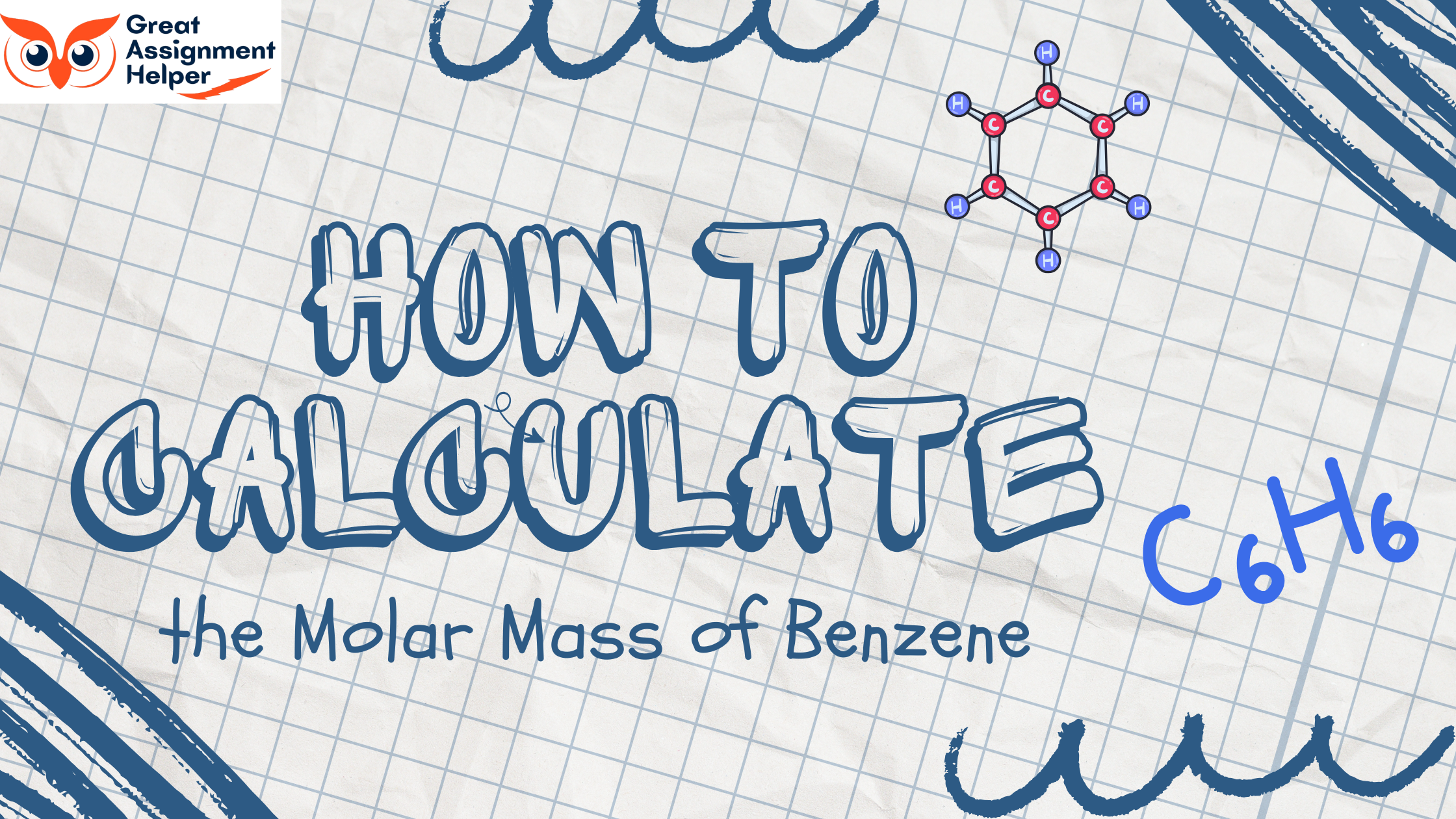
Chemistry is a branch of natural science that explores substances, their composition, structure, properties, and the reactions they undergo. It also examines the fundamental laws that govern these transformations.
Given the vastness of the subject, students often struggle with calculations involving atomic mass, molecular mass, and moles. To simplify these concepts, we’ll demonstrate how to calculate the molar mass using benzene as an example. The method outlined can be applied to any substance.
Listen To This Blog
Benzene: An Overview of This Chemical Compound Chemical Properties of Benzene:
- Chemical Formula: C₆H₆
- Molecular Formula: C₆H₆
- Empirical Formula: CH
- Molar Mass: 78.11 g/mol
- Atomic Weight: 78.11 g/mol
- Atomic Composition: Benzene consists of six carbon atoms and six hydrogen atoms arranged in a hexagonal ring.
- Boiling Point: Approximately 80.1 °C
- Melting Point: Approximately 5.5 °C
Benzene (also known as phenyl hydrogen) is a colorless organic liquid with a slightly sweet, pungent odor. It is a simple aromatic hydrocarbon and one of the most basic arenes. Benzene is known to be toxic, carcinogenic, and a common environmental pollutant.
Widely recognized as a component of gasoline, benzene is used across various industries. It plays a key role in the production of pharmaceuticals, veterinary medicines, plastics, synthetic rubber, dyes, and more. Although naturally found in crude oil, industrial benzene is often synthesized from its derived components.
Key Physical Properties of Benzene
Benzene is a colorless, transparent, and highly fluid liquid with a distinct aromatic odor. It burns with a bright, smoky flame and produces flammable vapors. At low temperatures, benzene solidifies into a crystalline form, melting at approximately 6°C.
It mixes well with many organic solvents, including ether, chloroform, cyclohexane, ethanol, methane, octane, toluene, xylene, and gasoline. However, it is nearly insoluble in water, with a solubility of just 0.08% at 22°C.
Benzene is an effective solvent for substances such as fats, resins, oils, asphalt, alkaloids, sulfur, phosphorus, and iodine. It can also form azeotropic mixtures with certain solvents.
Benzene: Chemical Characteristics and Behavior
Special attention should be given to the chemical structure of benzene. Each of the six carbon atoms is in an sp² hybridized state and forms bonds with two neighboring carbon atoms and one hydrogen atom, creating three sigma (σ) bonds.
The bond angles between each pair of π-bonds are 120°, resulting in a perfectly symmetrical hexagonal ring. In this structure, all carbon atoms and the C–C and C–H bonds lie in the same plane, forming a flat, planar molecule.
Benzene undergoes substitution reactions, reacting with compounds such as nitric acid, olefins, chloroalkanes, halogens, and sulfuric acid. The rupture of the benzene ring requires specific temperature and pressure conditions.
When benzene interacts with olefins, compounds like ethylbenzene and isopropylbenzene are produced. In the presence of a catalyst, reactions with chlorine (Cl₂) and bromine (Br₂) result in the formation of phenyl chloride. Other typical reactions of benzene include formylation, sulfonation, nitration, catalytic hydrogenation, oxidation, and ozonolysis.
Calculating the Molar Mass of Benzene: A Step-by-Step Guide
Calculating the molar mass of benzene is straightforward. Follow these steps:
Prepare the Periodic Table:
Access a periodic table (either from a chemistry book or online) to identify the atomic masses and valencies of elements.
Write the Chemical Formula:
Benzene has the chemical formula C₆H₆, indicating six carbon (C) atoms and six hydrogen (H) atoms.
Identify Atomic Weights:
Using the periodic table, note the atomic weights for carbon (C) as 12.0107 and hydrogen (H) as 1.00784.
Set Up the Calculation:
The formula for the molar mass is: Mr(C₆H₆) = (6 × Ar(C)) + (6 × Ar(H)) Mr(C₆H₆) = (6 × 12) + (6 × 1) = 72 + 6 = 78 g/mol
Final Step:
To find the mass of a single molecule, divide the molar mass by Avogadro's number (6.02 × 10²³): m(C₆H₆) = Mr(C₆H₆) / NA = 78 / 6.02 × 10²³ = 12.9 × 10⁻²³ g This completes the calculation, providing the molar mass of benzene.
Examples of Calculations Using the Molar Mass of Benzene
In chemistry, there are more complex tasks that involve calculating the molar mass of benzene. Let’s explore a couple of examples:
Task 1:
Problem: Calculate the mass of benzene produced from the dehydrogenation of 184.8 g of cyclohexane.
Solution: Start by writing the reaction equation: C₆H₁₄ → C₆H₆ + 4H₂
Find the number of moles of cyclohexane (ν) by dividing the mass by the molar mass: 184.8 g ÷ 86 g/mol = 2.15 mol Since the mole ratio between cyclohexane and benzene is 1:1, the number of moles of benzene is also 2.15 mol. Now, calculate the mass of benzene by multiplying the number of moles by the molar mass: 2.15 mol × 78 g/mol = 167.7 g
Answer: The mass of benzene is 167.7 g.
How Is Benzene Produced?
Benzene can be obtained by the following methods:
- Coking of coal raw materials
- Catalytic aromatization of petroleum gas fractions
- Pyrolysis of oil fractions (both gasoline and heavier)
- Trimerization of ethyne
Where Is Benzene Used?
Benzene is mainly used to produce:
- Ethylbenzene, cumene, and cyclohexane
- Various intermediate products used in manufacturing synthetic rubbers, plastics, fibers, dyes, insecticides, and pharmaceuticals.
- Additionally, it is used in the production of insecticides, blowing agents, flame retardants, and as a solvent in paints, varnishes, and motor fuels.
FAQ: Molar Mass of Benzene
What is the molar mass of benzene?
The molar mass of benzene (C₆H₆) is 78.11 g/mol.
What is the chemical formula of benzene?
The chemical formula of benzene is C₆H₆.
How do you calculate the molar mass of benzene?
To calculate the molar mass of benzene, multiply the atomic mass of carbon (12.0107 g/mol) by 6 and the atomic mass of hydrogen (1.00784 g/mol) by 6.
What is the boiling and melting point of benzene?
Boiling point: 80.1°C Melting point: 5.5°C Is benzene toxic? Yes, benzene is toxic and carcinogenic.
What are some common uses of benzene?
Benzene is used to make plastics, synthetic rubbers, fibers, and pharmaceuticals, as well as serving as a solvent in paints and motor fuels.
Read More: Understanding child psychology: Key concept, theories & Career Paths.

